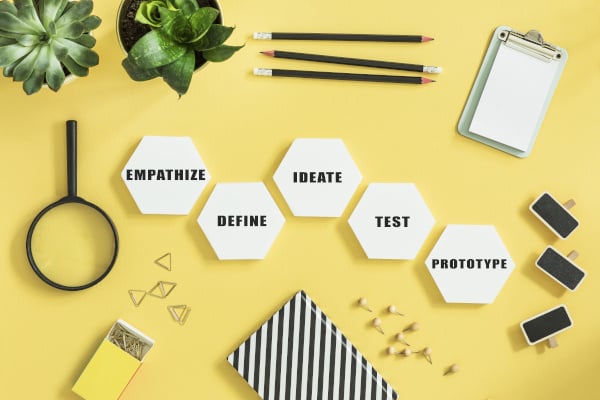 Companies looking for customer-centered innovation strategies often land on one of two methods: Agile or design thinking. Both of these problem-solving strategies rely on a similar approach around gathering feedback from customers and conducting iterative design cycles. Both strategies also promise to inspire creativity, help teams avoid mistakes and generate better products, faster. So which one is right for you?
Companies looking for customer-centered innovation strategies often land on one of two methods: Agile or design thinking. Both of these problem-solving strategies rely on a similar approach around gathering feedback from customers and conducting iterative design cycles. Both strategies also promise to inspire creativity, help teams avoid mistakes and generate better products, faster. So which one is right for you?
While similar in many ways, the two strategies are not interchangeable.
What is Agile?
Agile is an approach to project management. People are organized into short and nimble design sprints where they get rapid feedback over several cycles of iterative releases to address user needs. The Agile Manifesto, released in the early 2000s as a way for project managers to build responsive lead time into software design, outlines the fundamentals of the methodology and how to run design sprints, generate useful feedback and build for iterative design. Agile gave developers a new way to approach project management and the freedom to test new ideas, gauge user response and pivot quickly — and all early enough in the design cycle while it was easy, safe and affordable.
Sound familiar? It should.
The fundamentals of Agile project management come from the same theories and practices that define design thinking. Consider the first of the 12 principals defined in the Agile manifesto: “Our highest priority is to satisfy the customer through early and continuous delivery of valuable software.” Replace the word “software” with whatever problem you’re trying to solve, and you’ve got the foundation for any good design thinking project.
What is design thinking?
Design thinking is a method that helps people identify and uncover real problems that need solving, address potential risks, collaboratively problem-solve and generate innovative designs that are low-risk, fast and easy to produce. It follows a six step process (see below) and offers a framework for engaging with customers, driving creativity, and testing to learn.
Like Agile, design thinking is based on treating customers as collaborators, gathering their feedback throughout the design process, and using that feedback to drive iteration. It leaves room for users to tell you when what you’ve built isn’t working and time to solve for it.
How the methods differ
Agile is a method for solving predefined problems; design thinking focuses on finding the right problems to solve. This is an important distinction, as design thinking provides people with a way to see the entire problem from multiple starting points and helps them become comfortable with the journey, even if they don’t always know the final destination. Agile, on the other hand, tells people what the destination is, but not how to get there.
From an industry perspective, Agile is best known as a project management method optimized for software development, whereas design thinking can be used by anyone in any industry to solve problems both big and small. It’s especially valuable when there’s no clear solution.
Agile requires user engagement, but design thinking actually teaches you how to engage users for useful feedback. A good design thinking workshop will teach you how to listen to customers and observe their behavior so you can empathize with their needs and identify what problems actually require solving. This is one of the most important differences between the two methods, and the main reason design thinking was voted the best framework for helping companies create innovative products, beating out Agile, Lean and several other frameworks. Agile teams can talk to end users on a daily basis, but if they don’t have the skills to listen and respond to their needs then those interactions won’t add actionable value.
Fortunately, you don’t have to choose one over the other. These two methods complement each other and can be used as part of a broader effort to be more customer centric and innovative.
When software developers learn to use design thinking to talk to customers, they do a better job of gathering feedback and responding to the right information. In turn, design thinkers can benefit from adopting agile strategies and processes, like daily stand-ups and sprints, in order to drive better collaboration and communication on their teams.
Together, these two methods can transform your organization and ensure every project delivers high value to your business, your customers, and your own bottom-line.